Trans-NIH Recruits
Welcome to the New Stadtman Investigators and Lasker Scholars
The Intramural Research Program (IRP) is proud of its trans-NIH recruiting programs that are designed to attract talented early-career scientists to NIH (the institutes do their own recruiting, too). In 2009, the IRP launched the Earl Stadtman Tenure-Track Investigator Program—named for the legendary biochemist who worked at NIH for 50 years—which aims to recruit a diverse group of scientists pursuing interests across the biomedical research spectrum.
In 2010, the IRP announced the Lasker Clinical Research Scholars Program, an “intramural–extramural” NIH program in partnership with the Albert and Mary Lasker Foundation. It funds a small number of exceptional clinical researchers in the early stages of their careers. In the current program, the scholars can work as principal investigators at NIH for five to seven years and then can either remain on the IRP tenure track or move—with three years of research funding—to a university or other research institution.
This issue of the NIH Catalyst introduces the 10 Stadtman Investigators from the 2012-2013 recruitment cycle (they join 28 other Stadtmans) and the five newest Laskers (who join five others in the Lasker program). We posed all sorts of interesting questions, only some of which were included in the print version of this publication.
STADTMAN INVESTIGATORS
Grégoire Altan-Bonnet, Ph.D.
Earl Stadtman Investigator, Cancer and Inflammation Program, National Cancer Institute–Center for Cancer Research
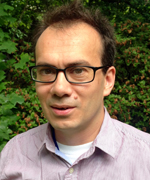
Education: École Normale Supérieure, Paris (B.S. in physics, 1994; M.S. in physics, 1995); The Rockefeller University, New York (Ph.D. in physics, 2000)
Training: Postdoctoral fellow, Laboratory of Immunology, National Institute of Allergy and Infectious Diseases (2000–2005)
Previous positions: Departments of Computational Biology and Immunology, Memorial Sloan-Kettering Cancer Center, New York (2005–2015)
Came to NIH: In 2015 as a Stadtman Investigator
Research Focus: I have been trained in statistical physics and nonlinear dynamics (Ph.D. at Rockefeller University) and in immunology (postdoctoral studies with Ron Germain at NIAID). My expertise is in the field of systems immunology: the Immuno Dynamics group that I started at Memorial Sloan Kettering and that is now moving to the NCI’s Cancer and Inflammation Program has been developing experimentally validated quantitative models of different aspects of the immune response, from signaling responses to antigens and cytokines, to differentiation and proliferation of T lymphocytes. In particular, we have addressed the interplay between the robustness and variability of self-nonself discrimination in the immune system. We are also focused on developing quantitative models of immune-cell communications via cytokine exchange in the context of immune responses to infections or to tumors.
How did you become interested in science and your field?
My main fascination and research focus has been the question of molecular specificity and complexity in biology: How do biological systems “process” their environment, sense molecular cues at the microscopic level, and self-organize to respond at the macroscopic level? These are particularly cogent problems in immunology. One of the key paradoxes we are addressing is that cells of the immune system must be sufficiently flexible to adapt to multiple pathogenic onslaughts, yet very much reliable and “self-aware” to avoid autoimmune catastrophes.
What is most exciting about your work?
The field of immunology is experiencing a massive explosion with more and more of the immune system being explored in its intimate details. We have now accumulated an encyclopedic compendium of immunological parts. Today’s challenge is to navigate, tame, and drive the immune system. An analogy would be that we have drawn a map, but we are only starting to learn how to navigate the system in a practical manner. For that purpose, the development of systems immunology (the ability to build quantitative models of the immune response) is really taking off and shifting paradigms for our understanding of the immune system.
There are practical applications in the clinic with the development of immunotherapies against cancer and autoimmune disorders. There are also huge conceptual payoffs with the understanding of a complex system that reconciles homeostasis, explosive responsiveness, and sustained biodiversity.
Have you made any significant findings?
The main contributions for my group were, first, to analyze how cells of the immune system display large phenotypic variability, such as in their response to stimuli while being isogenic. We then demonstrated that cell-cell communications and feedback regulations could correct such unreliability at the individual cell level and enforce a reliable collective response within a population of cells. Our work then documented how self-nonself discrimination by T cells can be tuned at the collective level, in particular through a stug of war for shared cytokines.
What attracted you to the NIH IRP?
The NIH IRP is truly an exceptional institution in terms of scientific depth and resources. We find experts in every field of biology, and the collaborative spirit of the institutes is stimulating. We are looking forward to collaborating with researchers, within the Cancer and Inflammation Program of NCI and beyond, to developing the field of systems immunology.
At the personal level, joining the intramural research program in Bethesda offers the opportunity to have our family in one place. Nihal, my wife, moved her lab to the National Heart, Lung, and Blood Institute in 2013, with our two kids in tow, while I maintained my group at Sloan-Kettering in New York City. These two-and-a-half years of N.Y.-D.C. split were suboptimal for us, both professionally and family-wise.
What’s hot in your field right now?
Single-cell methodologies are taking center stage. Although the ability of immunologists to monitor individual lymphocytes has long been established with flow cytometry, recent developments in sequencing, single-cell manipulations, and imaging allow immunologists to monitor it all. The challenge for us is to sort out the functionally relevant from the merely statistically significant observations. Developing methods that bridge big-data processing and theoretical modeling is the challenge of the coming years. The payoffs will be both conceptual and practical, with a better understanding of the immune system and the ability to develop new immunotherapeutic manipulations to eradicate tumors and tame autoimmune disorders.
What do you like to do outside of work?
Hiking and camping in the wilderness (we have a soft spot for the national parks in the Southwest), reading history, playing the piano, and of course cooking: excuse my French, but nothing beats a good meal with friends and colleagues!
Complete this sentence: If I had more time I would …
Learn foreign languages, travel, and study ancient civilizations. I am a strong believer in the cross-pollination of cultures, and I am fascinated and humbled by the diversity of human experiences. We have so much to learn from the intellectual journeys that others have taken before us or are taking around us.
What’s the hardest lesson you’ve ever had to learn?
No matter how novel our results and conceptual insights are, their impact will be limited by our ability to communicate and validate our methods. There can be some reluctance on the parts of immunologists to appreciate mathematical modeling because genetics and cellular immunology have been so successful. It is up to us to cover all bases, from theoretical work to in vitro validation, in vivo testing, and clinical applications.
What about you might surprise most people?
Working in research taught me to appreciate the incredible diversity and flexibility of the human brain. I have collaborated with scientists with incredible scientific intuitions and/or with deep analytical skills. I hope that people might be surprised by our willingness to adopt very varied approaches to explore new scientific territories.
Alexander Chesler, Ph.D.
Earl Stadtman Investigator, National Center for Complementary and Integrative Health

Education: Bard College, Annandale-On-Hudson, N.Y. (B.A. in biology); Columbia University, N.Y. (Ph.D. in biology)
Training: Postdoctoral fellow, Columbia University (2005–2007); postdoctoral fellow, Department of Physiology, University of California at San Francisco (2007–2013)
Came to NIH: In 2013
Research focus: I have long been interested in how sensory input is detected and processed by the brain. My research focuses on the neurons and circuits of the somatosensory system and the changes that they undergo during injury and inflammation. Currently, my lab is working to discover new molecules involved in the transduction of somatosensory stimuli and studying the regions of the brain that encode innocuous versus painful stimuli. Our work centers on sensory neurons that encode thermal, noxious, and mechanical stimuli. We are using a variety of methods—physiology, two-photon imaging, bioinformatics, and behavior—to study transgenic mice.
How did you become interested in science and your field?
As a kid, I spent many hours at the American Museum of Natural History (New York). I attended Stuyvesant High School, a public school with an emphasis on science, technology, engineering, and mathematics. Yet by the time I graduated, I knew I didn’t want to be a doctor or engineer. Instead I decided that my college major would be painting. But soon I discovered the profound beauty of biological systems and that there was another career that never occurred to me—being a scientist. Biology lab experiments appealed to my need for creativity in uniquely satisfying ways—indeed, more so than painting or drawing. I also became fascinated with insects, especially ones that had co-evolved with particular plant species, and desperately wanted to understand the invisible chemical network that linked them. That’s how I first became interested in sensory biology, the field of olfaction, and later somatosensation.
What is most exciting about your work?
I aspire to carry with me the influence of my great mentors—playfulness, creativity, a love of the scientific process, fearlessness, insightfulness, and passion. Most exciting to me is the team I’ve put together (within my lab and with NIH collaborators) and how we are more then the sum of our parts. I feel incredibly fortunate to have the resources and security to take risks and to pursue my questions on what I believe to be the frontiers of our ignorance.
Have you made any significant findings?
Yes…but (of course) they are secret for now!
What attracted you to the NIH IRP?
There’s nowhere in the world with better resources. I’m surrounding by hundreds of scientists and doctors, state-of-the-art of equipment, and the freedom to pursue my research without the pressure of hunting for funding. One of the unexpected joys has been my ability to interact with patients and to feel, for the first time, directly connected to the health problems I seek to affect.
What’s hot in your field right now?
Everything! This feels like a golden age of neuroscience research. The tools are opening up so many new ways for me to understand the sense of touch and pain that it’s hard to pick just a few to focus on. My lab is working on mechanosensation, on how we sense innocuous stimuli like gentle touch, as well as on nociferous stimuli such as pinching, hair pulling, and punching. I believe that somatosensory research is on the verge of changing the way we view and treat acute and chronic pain. For me, true success would be to make basic-science discoveries that help us develop much-needed replacements for opiates that are safe and effective and really help people.
What do you like to do outside of work?
Hang out with my family. Go on long hiking and camping trips where we can get away from the noise, disconnect from our devices, and reconnect with each other. Otherwise, I mostly like cooking for people to make them happy (after all, you can’t eat your lab work).
Complete this sentence: If I had more time I would …
I have two small kids. If given any free time I mostly fantasize about sleep.
What’s the hardest lesson you’ve ever had to learn?
Being smart and working hard is not enough.
What about you might surprise most people?
At one point I was seriously considering dropping out of graduate school to tour with my band.
Kelvin Choi, Ph.D., M.P.H.
Earl Stadtman Investigator and Acting Head, Social and Behavioral Group, National Institute on Minority Health and Health Disparities
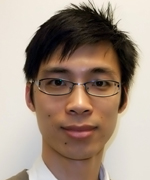
Education: The Hong Kong Polytechnic University, Hong Kong (B.Sc. in physiotherapy, 2001); University of Minnesota, Minneapolis (M.P.H. in community health education, 2007; Ph.D. in epidemiology, 2010)
Training: Attended training institutes through NIH’s Office of Behavioral and Social Sciences Research and the National Institute on Drug Abuse (2011–2012); Fundamentals of Team Science and the Science of Team Science through the National Science Foundation and University of Central Florida (2015)
Previous positions: Various positions, including assistant professor (2013), at the University of Minnesota School of Public Health, Division of Epidemiology and Community Health (2006–2013); clinic manager and physiotherapist, Cosmo Physiotherapy Center, Hong Kong (2001–2005)
Came to NIH: In 2013
Research Focus: I am interested in how tobacco companies use marketing strategies to cultivate and foster tobacco use among adolescents and adults and how the effects differ by demographics and socioeconomic status. I am collaborating on several studies including the FDA and NIH’s Population Assessment on Tobacco and Health Study, which examines tobacco-use disparities by socioeconomic status and the influence of tobacco marketing and tobacco-control policies; the National Institute of Child Health and Human Development’s Next Generation Health Study, which assesses disparities in tobacco use among adolescents and the impact of tobacco use on child development; a University of Maryland (College Park, Md.) study that examines rural-urban tobacco-use disparities among youth; and the International Tobacco Control Project, which examines how tobacco marketing contributes to the global tobacco-use disparities. The knowledge gained from these investigations will be used to construct more effective anti-tobacco interventions (for example, targeted anti-tobacco messages), tailored to smokers of disadvantaged populations, and public-health interventions for other health-risk behaviors.
How did you become interested in science and your field?
My mother died from lung cancer without smoking a single cigarette, but she was surrounded by smokers when she was younger. Later on, I worked with marginalized teenagers who often smoked, and I would have liked to help them quit smoking, but I didn’t know how. During my graduate education, I came to realize the complexity of social and behavioral changes and became interested in conducting research in tobacco-use epidemiology, its disparities, and tobacco control.
What is most exciting about your work?
Finding ways to help individuals and communities, particularly disadvantaged populations, to reduce the burden of tobacco use and other health-risk behaviors.
Have you made any significant findings?
I have published many papers on the exposure to and impact of direct-to-consumer tobacco marketing on youth and adult smoking behaviors. My work supports tobacco-control policies that regulate this type of marketing. My research team has also documented the disparities in susceptibility to smoking and smoking-related beliefs across racial and ethnic youth groups.
What attracted you to the NIH IRP?
I am excited to be part of the National Institute on Minority Health and Health Disparities (NIMHD) and to be able to conduct research that aims to develop approaches to reduce and eliminate behavioral health disparities. The institute is positioned to address disparities across multiple diseases and conditions and the upstream causes of health disparities, including health-risk behaviors.
What’s hot in your field right now?
One hot topic is electronic cigarettes. The product is so new that we lack of conclusive evidence on its health risks, its role in tobacco use and tobacco-use disparities, and the population-level risk-benefit analysis. I have done some work in this area. Another hot topic is how to reduce the tobacco-use disparities by socioeconomic status. Previous studies have shown that anti-tobacco campaigns are not helpful in reducing tobacco-use disparities and may even increase the disparities. How to effectively communicate to disadvantaged populations through health messages is part of my research at NIH.
What do you like to do outside of work?
I enjoy time with my family, especially traveling with my wife and little daughter. I am also an outdoor person. I like hiking, biking, camping, and other outdoor activities.
Complete this sentence: If I had more time I would ...
Work with a local disadvantaged community to empower its members to improve their health. I also would like to travel to Europe with my family to taste some chocolate.
What’s the hardest lesson you’ve ever had to learn?
It’s important to spend quality time with the family. I lost too many family members before I could enjoy life with them.
What about you might surprise most people?
My age. People often guess I am much younger than I actually am.
Shuo Gu, Ph.D.
Earl Stadtman Investigator, Gene Regulation and Chromosome Biology, National Cancer Institute-Frederick
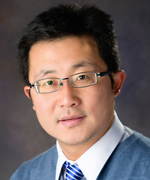
Education: Tsinghua University, Beijing (B.S. in biology, 1998); City of Hope Graduate School of Biological Sciences, Duarte, Calif. (Ph.D. in molecular biology, 2005)
Training: Postdoctoral fellow, Beckman Research Institute, City of Hope (2005–2006); postdoctoral scholar, Departments of Pediatrics and Genetics, Stanford University, Palo Alto, Calif. (2006–2011)
Previous position: Basic Life Sciences Research Associate, Departments of Pediatrics and Genetics, Stanford University (2011–2013)
Came to NIH: In 2013
Research Focus: My research aims to unveil the roles of noncoding RNAs in gene regulation and develop new therapeutic approaches for cancer treatment. MicroRNA (miRNA), a small noncoding RNA, plays an essential role in gene-regulation networks, human diseases, and cancer. We are interested in understanding the mechanisms of miRNA biogenesis, post-transcriptional modifications, and biological functions in mammalian systems. This information will then be used to test novel RNA-based approaches to alter gene expression with improved safety, off-targeting, and potency profiles, which can then be used as tools for biological discovery and therapeutics.
How did you become interested in science and your field?
As a kid, “why” was one of my favorite words. I guess curiosity drove me to the science field.
What is most exciting about your work?
We study the function of RNA, the origin of life (according to the RNA world hypothesis). People used to believe RNA is merely a messenger that conveys genetic information. Recent studies indicate RNA, especially noncoding RNA, plays a critical role in the regulation of gene expression. I am excited to see that more people agree that “RNA rules!”
Have you made any significant findings?
Our findings are focused on elucidating the fundamental mechanisms of miRNA and RNA interference pathways. In one study, I established a “loop-counting” rule governing the preciseness of how various small hairpin RNAs (shRNAs) and endogenous pre-miRNAs are processed, which is critical for miRNA biogenesis and function. Applying this rule, I was able to design shRNAs with fewer off-targeting effects in therapeutic treatments of various diseases.
What attracted you to the NIH IRP?
Stable funding, excellent institutional intellectual atmosphere, and strong core facilities.
What’s hot in your field right now?
RNA modifications and their functions in normal development and disease.
What do you like to do outside of work?
Reading and swimming.
Complete this sentence: If I had more time I would …
pursue two additional Ph.D. degrees in mathematics and physics. I guess my childhood dream of being Einstein never completely died out.
What’s the hardest lesson you’ve ever had to learn?
A model (or hypothesis) that makes perfect sense might not be the correct one.
What about you might surprise most people?
I used to be a very serious personal computer (PC) game player. The first publication I had in college was not for science but a strategy guide for a PC game.
Markus Hafner, Ph.D.
Earl Stadtman Investigator, National Institute of Arthritis and Musculoskeletal and Skin Disease
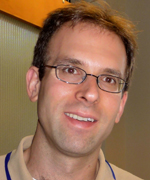
Education: University of Bonn, Bonn, Germany (M.Sc. in chemistry, 2002; Ph.D. in biochemistry, 2007)
Training: Postdoctoral fellow, The Rockefeller University, New York (2007–2014)
Came to NIH: In 2014
Research focus: I am focusing on the dissection of the composition of ribonucleoproteins (RNPs) that are involved in cellular RNA transport and control of RNA stability. All cellular RNA, including messenger RNA (mRNA), is packaged into distinct RNP complexes to orchestrate RNA maturation and turnover processes summarized as post-transcriptional gene regulation. Among the challenges for decoding post-transcriptional gene regulation is the elucidation of the mRNP composition, which changes as mRNAs mature or are translated. This is a prerequisite for understanding the consequences of dysregulation and/or mutation of RNA-binding proteins and/or their target RNA-binding sites in disease.
How did you become interested in science and your field?
I am a chemist by training, and during the work for my graduate thesis I used so-called RNA aptamers (synthetic RNA designed to specifically recognize target molecules, such as proteins, other RNA, and even metabolites) to set up screening assays with the goal of identifying small-molecule inhibitors of extracellular signaling pathways. I got fascinated by the versatility of RNA and decided to join Thomas Tuschl’s laboratory at the Rockefeller University to learn how the cell itself finds use for RNAs of different lengths.
What is most exciting about your work?
Understanding the exquisite specificity and the robustness with which cells regulate their gene-expression program.
Have you made any significant findings?
In my doctoral thesis I used chemical biology approaches to show that proteins of the cytohesin family of small guanosine exchange factors are in fact regulators of the insulin-signaling pathway. This was the first time I was working on fascinating molecular-biology problems and also got me thinking about gene regulation. During my postdoctoral work, I developed a method (called PAR-CLIP) to identify binding sites of RNA binding proteins on a transcriptome-wide scale with nucleotide resolution.
What attracted you to the NIH IRP?
The NIH Bethesda campus is a wonderful place to begin a career as an independent scientist. Obviously, the stable funding is an important factor, but even more than that, the density of successful scientists that can be found here, working on a broad range of topics, from the most basic research to the clinic, means that it is easy to find guidance and collaborations for any research problem I would like to tackle. In addition, I find the collegial and open atmosphere on campus very attractive.
What’s hot in your field right now?
The revolution in sequencing technologies led to the realization that large parts of the genome are transcribed even though they are not coding for proteins. Identifying the function of the resulting noncoding RNAs is one of the big challenges in the field of RNA molecular biology.
What do you like to do outside of work?
The Washington, D.C., area is almost perfectly suited to my interests. I can relax by biking or running along the Potomac and on other trails, or take in shows at the Kennedy Center and visit the museums on the National Mall.
Complete this sentence: If I had more time I would …
…love to read and travel more.
What’s the hardest lesson you’ve ever had to learn?
That, in some rare cases, trust in collaborators can be misplaced. But at the same time, I am making sure that my positive attitude toward open collaborations does not change.
Lisa Mirabello, Ph.D., M.S.
Earl Stadtman Investigator, Genetic Epidemiology Branch, National Cancer Institute
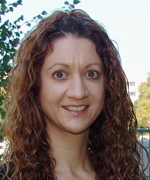
Education: Cornell University, Ithaca, N.Y. (B.S. in pre-medicine and animal science, 1999); New York Medical College, Valhalla, N.Y. (M.S. in experimental pathology, 2003); State University of New York at Albany, School of Public Health, Albany, N.Y. (Ph.D. in infectious disease and molecular population genetics, 2007)
Training: Postdoctoral fellow, Clinical Genetics Branch, Division of Cancer Epidemiology and Genetics, NCI (2007–2010)
Previous positions: Research fellow, Clinical Genetics Branch, Division of Cancer Epidemiology and Genetics, NCI (2010–2013)
Became Stadtman Investigator: In 2013
Research Focus: I am interested in understanding the contribution of genomic and epigenomic alterations to cancer etiology. I am focusing on the germline genetic etiology of osteosarcoma, the most important bone tumor in children and adolescents. I use genomic data to evaluate the role of common and rare genetic variation in osteosarcoma risk and outcome. My other main focus is on carcinogenic human papillomavirus (HPV) genomics. I am leading an HPV genomics project aimed at identifying the viral genetic basis of HPV carcinogenicity. This project is worthwhile as an etiologic goal, but might also lead to even better preventive, and perhaps therapeutic, tools.
How did you become interested in science and your field?
As a child, I imagined becoming a veterinarian. As an undergrad, I studied pre-medicine and animal science at Cornell. As time passed I became more interested in why animals and people were sick, the underlying etiology of their disease. My interests led me to a master’s in experimental pathology and ultimately a Ph.D. in infectious disease and population genetics. I became completely fascinated by the genetics of disease during my Ph.D. work on the population genetics of a malaria vector in South and Central America. This work helped explain the epidemiology of malaria and inspired my interest in public health. It eventually led me to think about cancer epidemiology and ways that I could apply my unique background in population genetics to understand why people get cancer.
What is most exciting about your work?
Finding something new that may help explain disease risk or outcome.
Have you made any significant findings?
I have made several important findings this past year. I led a study to sequence the tumor suppressor gene TP53 and showed that inherited variations in TP53 among children and adolescents with osteosarcoma are more common than previously thought—nearly 10 percent of these younger patients have a variant. We determined that genetic susceptibility to young-onset osteosarcoma is distinct from older-adult-onset disease. In another study with important translational implications, I conducted an osteosarcoma genome-wide association study to identify variants associated with osteosarcoma metastasis. Metastasis is the leading cause of death in osteosarcoma patients, and few factors have been consistently associated with risk of metastasis. Our analysis led to an important finding, the identification of a novel genetic locus (NFIB) strongly associated with metastasis at diagnosis in 935 osteosarcoma patients. As part of the HPV genomics project, we developed the first high-throughput HPV16 next-generation sequencing method. This was a huge advance for the field because it permits the large-scale study of HPV16’s (the most carcinogenic HPV) genome-wide variability among thousands of HPV-positive cervical cancer cases and control subjects; and, this will help to identify the HPV sequence-specific differences that provide clues about why some HPV infections are carcinogenic and most others are benign.
What attracted you to the NIH IRP?
The NIH IRP allows me to have such wonderful independence and intellectual freedom. One thing I find to be a great advantage to working at NIH is the breadth of research being performed here; when I need advice in an area outside my expertise I can always find a collaborator to discuss ideas with. I love the scientific resources here. Within NCI, I work with a wonderful team of diverse investigators from different backgrounds and areas of expertise (including biostatistics, epidemiology, genetics, and oncology). This diversity is a great advantage and allows us to work together to think through our research questions and problems as a team.
What’s hot in your field right now?
“Omics” in general is hot right now.
What do you like to do outside of work?
I am a devoted mother and wife, my second job. I love teaching my son. He is 5 years old and learning to read, so lately I spend a lot of time reading to him and teaching him how to read. I also love to garden. I have a house full of plants, a huge vegetable garden, and berry bushes.
Complete this sentence: If I had more time I would …
spend some time teaching. Mentoring is a great part of my job. I enjoy teaching young scientists.
What about you might surprise most people?
I’ve been a vegetarian since I was 6 years old. When I was 6 and understood where meat came from, I cried and then decided I never wanted an animal killed for me to eat. As a child I thought I was making a difference, helping the animals, reducing some suffering. I think it’s this same compassion that drives my passion for my research, the hope to make a difference by improving human health.
Steven C. Moore, Ph.D., M.P.H.
Earl Stadtman Investigator, Nutritional Epidemiology Branch, National Cancer Institute–Division of Cancer Epidemiology and Genetics
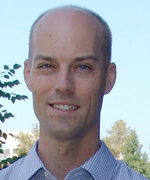
Education: Williams College, Williamstown, Mass. (B.A. in psychology, 2000); Yale University School of Public Health, New Haven, Conn. (M.P.H., 2004; Ph.D. in cancer epidemiology, 2007)
Training: Predoctoral fellow, NCI-DCEG (2005–2007); postdoctoral fellow, NCI-DCEG (2007–2009)
Previous position: Research fellow, NCI-DCEG (2009–2013)
Came to NIH: In 2007 for training; became Stadtman Investigator in 2013
Research focus: My research focuses on 1) the role of physical activity and obesity in cancer risk and 2) the use of metabolomics—a method used to analyze thousands of metabolites in blood samples simultaneously—to study human populations. In particular, I am developing large consortium-based studies. For physical activity, I and co-investigators have pooled data from 12 large cohort studies including more than a million research participants. For metabolomics, I am the chair of the Consortium of Metabolomics Studies, a consortium of 22 prospective studies utilizing metabolomics to improve our understanding of human health.
How did you become interested in science and your field?
Like a lot of other people who love math and computers, I got my start as a kid with board games, Dungeons and Dragons, polyhedral dice, and back-of-the-envelope probability calculations. In high school, I started running competitively and became a health nut. Eventually, my science and computer interests and health interests converged.
What is most exciting about your work?
Making new discoveries. Some new findings, such as certain biomarkers of diet, can just pop right out of the data, plain as day.
Have you made any significant findings?
In my physical activity research, I and co-investigators identified the exact dose-response relationship between physical activity and life expectancy gained. We also showed that the benefits also extend to most ethnic and socioeconomic groups and, moreover, that really high levels of physical activity (such as 10 times the minimum recommended levels) do not pose a hazard. This work provides important support for the U.S. HHS physical activity recommendations for Americans.
In metabolomics, I and co-investigators have been evaluating how key health habits and personal characteristics are related to more than 1,000 different metabolites in blood. So far, we’ve identified up to 50 biomarkers related to diet, including new biomarkers of nuts, fish, coffee, and tea. We’ve also identified new biological pathways affected by body weight that may also be relevant to cancer risk.
What attracted you to the NIH IRP?
The IRP gives investigators the ability to pursue their work with a singular focus, free from grant writing and certain academic responsibilities. This allows us to conduct long-term and high-risk research that would be difficult to do in the extramural community.
What’s hot in your field right now?
Metabolomics has been very effective is revealing the pathogenic biological changes that occur with obesity, such as high concentrations of branch-chain amino acids. These biological discoveries give us clues about why obesity causes disease and suggest possible therapeutic targets.
What do you like to do outside of work?
Spend time with my wife and my two sons. Go running.
Complete this sentence: If I had more time I would…
Go hiking in the Shenandoah mountains and visit old friends.
What’s the hardest lesson you’ve ever had to learn?
That I was not going to make it as a professional runner. Not even close.
What about you might surprise most people?
I seriously considered becoming a professional photographer. I talked to a newspaper staff photographer before leaving college, and he explained to me how the Internet was undercutting the profession. He gently suggested that I consider an alternate career path.
Keisuke (Chris) Nagao, M.D. Ph.D.
Earl Stadtman Investigator, Dermatology Branch, National Cancer Institute–Center for Cancer Research

Education: Keio University School of Medicine, Tokyo (M.D., 1994; Ph.D. in microbiology and medical mycology, 2005)
Training: Residency in dermatology, Keio University School of Medicine, and residency in anesthesiology, Tokyo Dental College Hospital, Toyko (1994–1996); visiting fellow, Dermatology Branch, NCI-CCR (2005–2008)
Previous positions: Plastic and Reconstructive Surgery, Shizuoka Red Cross Hospital, Shizuoka, Japan (1996–1997); Department of Dermatology, Shimizu Municipal Hospital, Shizuoka (1997–2000); Department of Dermatology, Keio University School of Medicine (instructor, assistant professor, then senior assistant professor, 2008–2014)
Came to NIH: In 2005–2008 as visiting fellow; returned in 2014 as a Stadtman Investigator
Research focus: My lab seeks to elucidate fundamental principles relating to skin inflammation and immunology, building a foundation that will result in novel strategies for controlling local and systemic immunity via skin in infection, allergy, and cancer. We are exploring the cross-talk between skin-resident leukocytes and unique skin structures as well as skin-colonizing microbiota, which support leukocyte residency in skin during steady state and inflammation. I previously discovered that hair follicles play an important role in skin dendritic-cell trafficking by producing chemokines in response to physical trauma. More recently, we have demonstrated that hair follicles produce T-cell homeostatic cytokines and that both nonmalignant and malignant skin resident T cells depend on these hair-follicle‐derived cytokines for cutaneous persistence.
How did you become interested in science and your field?
I am a dermatologist with a longstanding interest in immunological skin diseases. Having encountered severe and fatal cases of infectious diseases led me to recognize the importance of skin immunity. Interactions with my mentors who are also physician–scientists made me realize the importance for clinicians not only to gain textbook knowledge of diseases, but also to actively explore the unknown mechanisms of diseases and skin function to be able to contribute to better human health.
What is most exciting about your work?
The skin harbors vast numbers of resident leukocytes and is an active site for immune responses. Uncontrolled inflammation in the skin can lead to inflammation in other organs (such as asthma arising subsequent to atopic dermatitis). However, our understanding of mechanisms that regulate skin immunity is far from complete. My lab explores the fundamental mechanisms that regulate skin immune homeostasis. As a clinician, I have the opportunity to explore basic skin immunity and think about the significance of our findings in the context of relevant diseases.
Have you made any significant findings?
We recently made a mouse model of atopic dermatitis (AD) that recapitulates not only the phenotype but also the dysbiosis (loss of microbial diversity) seen in human AD. Using this model, we showed that Staphylococcus aureus, which colonizes AD skin, is a critical component for eczema formation. This finding should provide impetus to design novel therapeutic strategies for AD.
What attracted you to the NIH IRP?
I did my postdoctoral fellowship here at the NIH in the lab of Mark Udey. I went back to Japan to serve as faculty after that, but it had always been my dream to come back as a principal investigator. Having seen science in another country, I feel that the scope of science is incomparably broad at the NIH—not limited to certain fields or diseases, but as a whole, working for the sake of global human health. Needless to say, the environment that the NIH provides is fascinating, and being able to meet with great scientists inspires me to do better science.
What’s hot in your field right now?
As in other field, microbiome studies have attracted the interest of dermatologists and clinicians. Microbiota-host interactions will likely be a field that will remain important. However, because many studies (including ours) are done in mice, it will be important to recognize the difference between mice and humans, and we will need to set up models that can be translatable to humans.
What do you like to do outside of work?
Read and cook.
Complete this sentence: If I had more time I would …
Go fishing.
What’s the hardest lesson you’ve ever had to learn?
During my early training as a physician, it was difficult for me to learn and accept that lives of patients sometimes just cannot be saved.
What about you might surprise most people?
The fact that I’m a scientist seems to surprise my old friends.
Is there anything else you’d like to add?
I look forward to interacting with more people here at the NIH!
Bríd M. Ryan, Ph.D., M.P.H.
Earl Stadtman Investigator, Laboratory of Human Carcinogenesis, National Cancer Institute-Center for Cancer Research
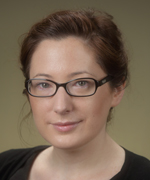
Education: University College Cork, Cork, Ireland (B.Sc. in biochemistry, 2001); St. Vincent’s University Hospital and School of Medicine and Medical Sciences, University College Dublin, Dublin, Ireland (Ph.D. in biochemistry, 2005); School of Public Health and Population Sciences, University College Dublin (M.P.H., 2007)
Training: Postdoctoral researcher, Breast Cancer Research Group, St. Vincent’s University Hospital (2005–2006); Cancer Prevention Fellow (2006–2010), postdoctoral research fellow (2010–2013), Laboratory of Human Carcinogenesis, NCI
Came to NIH: In 2007 for training; became Stadtman Investigator in 2013
Research Focus: My lab uses integrative and translational molecular epidemiology approaches. We have taken an integrative genomic approach to try and understand the causes and consequences of health disparities in lung cancer among African-Americans. The etiological, genetic, and biological reasons behind these disparities are not well understood. Some of our research questions address the potential causes of these disparities, with a view toward integrating our findings into cancer-prevention strategies, while other research questions examine the consequences of these disparities. We anticipate that our findings will be translated into improved patient care and outcomes for African-American lung-cancer patients. I am also involved in a trans-NIH team-science study that is looking at the role of inflammation in the initiation and progression of lung cancer. My lab is leading an aspect of this effort that leverages the inflammatory contribution to lung cancer for the purposes of improved diagnostics and prognostic tools. We are focused on stage 1 lung cancer, in which almost 30 percent of patients have poor outcomes. Our research is examining whether a circulating inflammatory signature can prospectively identify this subgroup of patients so that they can receive the necessary treatment. While not only reducing patient morbidity and economic cost, this work may also lead to improved patient outcomes.
How did you become interested in science and your field?
I was always interested in science. In school it was my favorite subject, and I was always asking questions, which I’ve come to realize is a large part of being a scientist. In my teens I decided to be a cancer researcher. My initial training was in biochemistry, but as part of the NCI Cancer Prevention Fellowship, I received training in public health. As a postdoc at NCI, I was involved in research that bridged both basic science and translational molecular epidemiology. Initially, I studied populations of European descent, but it became clear that, within the United States, significant disparities in incidence and survival existed across populations. The key question is “Why.” As a scientist, we often think about how our research can be translated to improve human health. I am excited to be contributing to the field.
What attracted you to the NIH IRP?
In my lab we first ask questions in human studies, take that insight and probe the mechanistic basis for it, and then, when possible, move that research back into human studies. That is a unique strategy that I believe could pay large dividends in terms of scientific insight. The IRP facilitates this model. In addition, the resources at NIH are outstanding, as is the openness and willingness among NIH scientists to interact and collaborate. I love that, no matter what directions my new findings take me, invariably there is an expert in that area here on NIH campus. Perhaps the greatest advantage is the long-term focus that drives our science and the ability to build a high-risk research program with the potential of high rewards. It is also a place of mentorship. I was a postdoc at NIH, so I knew that mentorship was a core part of its mission—I was very fortunate to have had Curt Harris as my mentor. One of the other reasons I was drawn to the IRP was the sense that the leadership here wants us to succeed—they back you from day one. That is a pretty special environment to work in.
What’s hot in your field right now?
Methods and technology. Many of our core research questions have not fundamentally changed during the past few decades, but advances in genomics and basic science have completely transformed how we ask them. A number of years ago, the field began to probe the molecular, genetic, and scientific basis of cancer health disparities. With each year, the granularity of the information we can obtain and dissect increases, meaning that the data trickle has become a tsunami. I believe that the strategy of my lab—to probe the mechanistic basis of our observational findings—is the best way to identify and validate observations that are clinically relevant, with high potential for improving public health and reducing health inequities.
What do you like to do outside of work?
I grew up on a farm in Ireland, so I like the outdoors. I like to go camping and hiking with my husband and friends. For the last five years, I have also been involved with a nonprofit group based in Washington, D.C., for people of—or who have an interest in—Irish ancestry and culture. That has been a tremendously rewarding experience, and I have also met some wonderful friends through that group.
What’s the hardest lesson you’ve ever had to learn?
I’m not sure if perseverance is the right word, but as a Ph.D. student I quickly learned that most experiments are not perfect the first time you try them and that we disprove most hypotheses. As a young, eager scientist, that was a bit of a not-so-pleasant surprise!
What about you might surprise most people?
I have five sisters and grew up on a farm, so I am quite accustomed to milking cows and herding cattle. My family is important to me, and I have been lucky in being able to visit Ireland while I have lived in the United States. We don’t have a dairy anymore, but we still have cattle, cows, and calves, so I swap the lab coat for overalls and wellies and do a bit on the farm each time I go home.
Peter Schuck, Ph.D.
Earl Stadtman Investigator and Chief, Dynamics of Macromolecular Assembly Section, Laboratory of Cellular Imaging and Macromolecular Biophysics, National Institute of Biomedical Imaging and Bioengineering
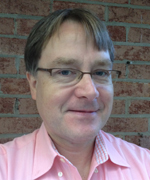
Education: Johann Wolfgang Goethe-Universität Frankfurt am Main, Frankfurt, Germany (B.S. in physics, 1991; Ph.D. in biophysics, 1994)
Training: Postdoctoral fellow, National Institute of Diabetes and Digestive and Kidney Diseases (1994–1997)
Previous positions: Visiting associate, Division of Bioengineering and Physical Science, NIH’s Office of Research Services (ORS), (1997–1999); chief, Protein Biophysics Resource, Division of Bioengineering and Physical Science, ORS (2003–2007); chief, Dynamics of Macromolecular Assembly Section, Laboratory of Cellular Imaging and Macromolecular Biophysics, NIBIB (2007–present); staff scientist (1999–2013)
Came to NIH: In 1994 for training; became Stadtman Investigator in 2014
Research focus: We study multiprotein complexes, which are ubiquitous in the molecular machinery of cellular processes such as signal transduction and the formation of an immune response. Our research focuses on the development of biophysical methods for studying protein interactions and the assembly of multiprotein complexes in solution or at surfaces, with regard to the number of assembly states and their size, shape, and interaction energetics. Ongoing projects are dedicated to the development of analytical ultracentrifugation, isothermal titration calorimetry, fluorescence methods, and optical biosensors and to the development of hybrid global multimethod approaches.
How did you become interested in science and your field?
I always enjoyed science and astronomy growing up and after high school enrolled in physics classes. Around that time I was introduced to biophysics and realized that it was a field that connected math, biology, and physics and offered many fascinating and important questions.
What is most exciting about your work?
To be able to determine how molecules interact with each other, what their structures look like, and to put that knowledge in the context of the inner workings of a cell. It is also fun to enable others to do the same and to see our techniques adopted in their work.
Have you made any significant findings?
We developed a method to deconvolute diffusion out of sedimentation velocity data to gain more information about how molecules interact. We also discovered the physical basis for the parallel evolution of the unusual amino acid compositions of eye-lens crystallins across different phyla. Recently we have embarked on the integration of fluorescence tricks with analytical ultracentrifugation, which offers exciting possibilities.
What attracted you to the NIH IRP?
NIH is the perfect place to develop new techniques: There are many groups on campus with technical expertise in almost anything; there’s a huge potential for collaborations to apply new tools to important biological problems.
What’s hot in your field right now?
Nanoparticles and photo-switchable molecules.
What do you like to do outside of work?
Spend time with my family, cook new recipes, barbecue, read science fiction novels, and play jazz piano.
Complete this sentence: If I had more time I would…
Finish some overdue projects, write a book, and travel more.
What about you might surprise most people?
A long time ago I used to play the tuba.
LASKER CLINICAL RESEARCH SCHOLARS
Rebecca J. Brown, M.D., M.H.Sc.
Lasker Clinical Research Scholar, Diabetes, Endocrinology, and Obesity Branch, National Institute of Diabetes, Digestive, and Kidney Diseases
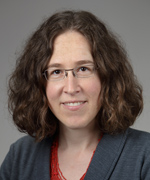
Education: Rice University, Houston, Texas (B.A. in chemistry, 1997); Mayo Medical School, Rochester, Minn. (M.D., 2002); Duke University, Durham, N.C. (M.H.S. in clinical research, 2010)
Training: Medical student, Laboratory of Brain and Cognition, National Institute of Mental Health (1999–2000); residency in pediatrics, Rainbow Babies and Children’s Hospital, Cleveland, Ohio (2002–2005); clinical fellow in pediatric endocrinology, National Institute of Child Health and Human Development (2005–2008); senior fellow in clinical research, NIDDK (2008–2012)
Other research positions: Assistant clinical investigator, NIDDK (2012–2015)
Research focus: Physiologic mechanisms by which the adipokine leptin alters insulin resistance and energy metabolism both dependent on and independent of its effects on food intake. I study patients with rare, often monogenic disorders of extreme insulin resistance, such as lipodystrophy or mutations of the insulin receptor. I apply what is learned from rare-disease models both toward the development of therapeutics for these rare diseases and to elucidate pathways that may serve as drug targets for more common disorders of insulin resistance.
How did you become interested in science and your field?
As a medical student, I had the opportunity to come to NIH as a Howard Hughes Medical Institute Scholar. At that time, I was interested in cognitive neuroscience. Ultimately, my clinical path led me away from neuroscience into endocrinology, but the knowledge and passion for human-subjects research that I gained during that time has continued to influence the direction of my career.
What is most exciting about your work?
I have the opportunity not only to research important questions about physiology but also to make a real difference in the lives of patients with rare disorders of extreme insulin resistance. To be able to help patients while conducting clinical research is a great privilege.
Have you made any significant findings?
My group recently found that treatment with the hormone leptin, which regulates appetite, helps improve metabolic disease in patients with both generalized and partial lipodystrophy as well as in patients with mutations of the insulin receptor. In addition, our ongoing work suggests that leptin has metabolic benefits that occur independently of its effects on appetite and food intake.
What attracted you to the NIH Intramural Research Program (IRP)?
One enormous advantage of working within the IRP is the ability to conduct sophisticated clinical research in a population of patients with rare diseases.
What’s hot in your field right now?
We are just starting to look into the potential of antisense oligonucleotides to reduce translation of proteins with adverse metabolic health consequences. This technology has an enormous potential to affect a broad spectrum of diseases, not just metabolic disorders.
What do you like to do outside of work?
I just became a mother, so most of my time outside work is spent enjoying the ups and downs of parenthood and family life.
Complete this sentence: If I had more time I would …
sleep more. But seriously, I would love to have more time to just sit and read the basic-science literature to get inspired by new ideas within and outside my field.
What’s the hardest lesson you’ve ever had to learn?
Clinical research is only possible if you can recruit and retain patients. When I first started out, I had studies that could not be completed due to inadequate recruitment and retention. Although frustrating, this was a valuable lesson for me.
Christian Hinrichs, M.D.
Lasker Clinical Research Scholar, Experimental Transplantation and Immunology Branch, National Cancer Institute
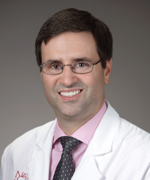
Education: University of Missouri–Kansas City, Kansas City, Mo. (combined 6-Year B.A./M.D. program, B.A. in biology, M.D. in 1996)
Training: Residency in general surgery, University of Missouri–Kansas City School of Medicine (1996–2001); fellowship in surgical oncology (Society of Surgical Oncology), Roswell Park Cancer Institute, Buffalo, N.Y. (2001–2003); fellowship in surgical oncology, NCI–Surgery Branch (2003–2005); fellowship in immunotherapy and tumor immunology, NCI–Surgery Branch (2005–2009); residency in internal medicine, The George Washington University School of Medicine and Health, Washington, D.C. (2009–2010); fellowship in medical oncology, NCI–Medical Oncology Branch (2010–2014)
Previous position: Assistant clinical investigator, NCI–Surgery Branch (2012–2015)
Research focus: Basic and clinical research to discover and develop novel T-cell therapies for the treatment of patients with cancer. This work includes a clinical trial of human papillomavirus(HPV)–targeted tumor-infiltrating T cells for patients with HPV+ cancers. The trial has demonstrated that this treatment can mediate complete regression of cervical cancer in some patients. Hinrichs’ laboratory also has discovered genes for T-cell receptors that target HPV, and his group is testing new gene-therapy treatments based on these receptors for patients with advanced HPV+ tumors.
How did you become interested in science and your field?
I was impressed with the ability of adoptive T-cell therapy to attack cells expressing target antigen but concerned with the side effects when the target antigen was shared by healthy tissues. Therefore, I became interested in cancers that express viral antigens that are ideal targets for T cells and absent from healthy tissues. I now study adoptive T-cell therapy for cancers that express viral antigens, primarily HPV-associated tumors.
What is most exciting about your work?
In some patients we have seen complete regression of widespread metastatic cervical cancers that is ongoing years after a single treatment with adoptive T-cell therapy.
What attracted you to the NIH IRP?
The NIH Clinical Center is a priceless resource for the types of clinical trials that I conduct. They could not be accomplished elsewhere.
What’s hot in your field right now?
Adoptive T-cell therapy with chimeric antigen receptors directed against CD19+ hematological cancers and treatment of diverse tumors with drugs targeted against the programmed cell-death protein 1 (PD-1) and its ligand PD-L1.
What do you like to do outside of work?
Spend time with my family and play with my kids (boys 4 and 7 years old). I also like running.
Complete this sentence: If I had more time I would …
Do more of what I love–cancer research and having fun with my family.
What about you might surprise most people?
I initially trained as a surgical oncologist.
Beth Kozel, M.D., Ph.D.
Lasker Clinical Research Scholar, National Heart, Lung, and Blood Institute
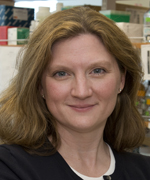
Education: Washington University in St. Louis, St. Louis (B.A. in biochemistry, 1996); Washington University School of Medicine, St. Louis (M.D., 2004; Ph.D. in cell biology and physiology, 2004)
Training: Residency in pediatrics, St. Louis Children’s Hospital, St. Louis (2004–2007); fellowship in medical genetics, Washington University School of Medicine–St. Louis Children’s Hospital (2007–2009)
Previous positions: Fellow-instructor, instructor, and assistant professor of pediatrics, Genetics and Genomic Medicine, Washington University (2009–2015) (an adjunct assistant professor there now)
Research focus: Understanding person-to-person variability in rare cardiovascular disorders such as Williams syndrome (WS), a multigene deletion disorder characterized by cardiovascular disease, developmental delays, deficits in visuospatial processing, and a striking overly friendly personality. Everyone with WS has an insufficiency in the elastin gene, but not everyone has significant vascular manifestations. Modeling genetic and environmental pathways in mice has allowed us to target therapies that improve the vascular phenotype. We are also looking at the impact of vascular flow abnormalities on end-organ perfusion and function in this population. In addition to the WS work, we collaborate with other groups to discover the genes and mechanisms responsible for new vascular disorders.
How did you become interested in science and your field?
I have always been interested in how gene changes lead to disease. In high school I did a report on the gene BRCA, which is mutated in breast cancer, and was enthralled. During my Ph.D., I studied elastic-fiber assembly in the extracellular matrix. But I got into my current area of interest during my M.D. training when I took care of patients with alterations in the genes I studied.
What is most exciting about your work?
Working with wonderful patients and their families. Learning new things from the patients and bringing those ideas back to the lab. Once we understand the process in a model, we go back to the patient and see whether we were right.
Have you made any significant findings?
Thanks to the large database we compiled, we have made many observations about features of WS that had only been hinted at in case studies. We also showed that variation in dosage of the gene NCF1 affects the severity of both hypertension and vascular stiffness. In our mouse work, we are working on treatment studies with multiple compounds and have some exciting candidates for treatment trials.
What attracted you to the NIH IRP?
The Clinical Center makes it easier for scientists who study rare diseases to recruit the patients they need. In addition we benefit from the collaborative atmosphere and access to sophisticated imaging techniques and drug trials.
What’s hot in your field right now?
The assessment of gene-by-gene and gene-by-environment interactions.
What do you like to do outside of work?
My husband and I have four children, and they keep us more than busy. On the weekends, when my oldest isn’t rowing, we have taken to the roads to explore the area. Every weekend is different.
Complete this sentence: If I had more time I would ...
The list is too long—there are so many things out there to learn and know and do.
What’s the hardest lesson you’ve ever had to learn?
Patience. Sometimes when you are pushing so hard, you can miss interesting details.
What about you might surprise most people?
That I have four children. People always seem a little shocked by that.
Is there anything else you’d like to add?
I am excited to be here. Since there are no grants to write, the Lasker provides a wonderful opportunity to do all of the science you had dreamed (and grant written) about.
Armin Raznahan, M.D., Ph.D.
Lasker Clinical Research Scholar and Chief of the Developmental Neurogenomics Unit, Child Psychiatry Branch, National Institute of Mental Health
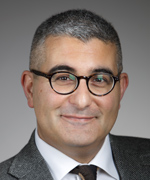
Education: King’s College, University of London, London (M.D., 1997); Institute of Psychiatry, King’s College, University of London (Ph.D., 2011)
Training: Medicine and surgery internship, King’s College Hospital, London (1997–1998); emergency room (ER) resident, King’s College Hospital (1999); residency in pediatrics, King’s College Hospital (1999–2002); residency in psychiatry, Bethlem Royal and Maudsley Hospitals, London (2002–2005); clinical academic fellowship in child and adolescent psychiatry at Institute of Psychiatry, King’s College London, and at Bethlem Royal and Maudsley Hospitals (2005–2008); clinical research training fellow at NIMH and Institute of Psychiatry, King’s College London (2008–2010); senior research fellow, Child Psychiatry Branch, NIMH (2010–2012)
Previous positions: Visiting scholar, Neurogenetics Program, University of California at Los Angeles, Los Angeles (2012–2013); staff scientist (2012–2014) and assistant clinical investigator (2014–2015), Child Psychiatry Branch, NIMH
Research Focus: I am trying to better understand the biology of childhood-onset neuropsychiatric disorders. Together with colleagues and collaborators, I work toward this goal by integrating two broad approaches. First, we use large-scale longitudinal neuroimaging datasets to study the architecture of brain development in healthy volunteers. By modeling how neuroimaging measures of the human brain vary with age, sex, and behavior in health, we hope to advance basic developmental neuroscience while also providing a data-driven way of selecting neuroimaging measures that should be prioritized for study in atypically developing groups. Second, we use a genetics-first strategy to study the relationship between atypical brain development and neuropsychiatric symptoms. This effort involves gathering deep-phenotypic data (spanning measures of gene expression, brain structure and function, psychophysiology, cognition, and behavior) in genetic disorders that increase risk for neuropsychiatric impairment. We harness these clinical data to empirically dissect the diverse biological pathways that can contribute to the emergence of neuropsychiatric syndromes. Cross-cutting themes of special interest within our unit include sex differences, allometry, and structure-function relationships within the central nervous system.
How did you become interested in science and your field?
I’ve been fascinated by the brain since high school and really connected with neurology and psychiatry during medical school. After medical school I interned at an ER department that had a dedicated pediatric section and discovered that I loved working with children and their families. These two interests came together during my pediatrics residency when I first encountered children who had been diagnosed with autism: I knew immediately that I wanted to dedicate my career to studying the biology of neurodevelopmental disorders. I’d had very little training in science up to that point though, so I went to the Institute of Psychiatry and Maudsley Hospital in London, which were known for their integrated neuroscience and clinical psychiatry program. My first real exposure to science happened there, and I was hooked. Having a job that was defined by thinking about the developing brain in the clinical and in the lab–together with amazing peers and teachers–it felt (and still feels) like hitting the jackpot every time you walk into work!
What is most exciting about your work?
The privilege of working with patients, the beauty of biology, and the joy of learning through collaboration.
Have you made any significant findings?
It depends on the yardstick really. None of the work I’ve done to date has any immediate use in the clinic–so as of now it’s pretty insignificant from the perspective of improving patient care. I hope, however, that my group’s basic-science studies can help to refine how questions are asked about the atypically developing human brain. At the same time, our clinical research is starting to define how genetic disorders that confer risk for autistic symptomatology alter gene function and brain development.
What attracted you to the NIH IRP?
I’m drawn to the NIH IRP because its infrastructure has an unparalleled capacity to support deep-phenotyping studies of rare patient groups. There are few places on Earth like the NIH Clinical Center for this sort of work! I also really value how working in the IRP allows one to carry out high-risk discovery science in a very nimble way. This sort of research can attract criticism from some quarters, but it properly acknowledges the depths of our ignorance about complex systems such as the brain and helps us target hypothesis testing in a less biased way.
What’s hot in your field right now?
Some of the most impactful movements in the field of psychiatric neuroscience and genetics right now are actually social. The growing emphasis on open science, data sharing, and patient-led research is fundamentally changing the sorts of questions we can address. In terms of specific technical developments, there is a huge amount of excitement around using induced pluripotent stem cells to model brain diseases in vitro. Its still unclear whether the “heat” surrounding these new tools will shed light that helps in the clinic though. We’re starting to pick at this question in our clinical studies by investigating links between in vitro and in vivo phenotypes across a range of genetic disorders.
What do you like to do outside of work?
Spending time with my wife and daughter. Cooking, listening to music, and dancing (usually at the same time). Drinking from the hose that is Twitter.
Complete this sentence: If I had more time I would …
Get a second Ph.D. in computational biology.
What’s the hardest lesson you’ve ever had to learn?
Time will tell.
What about you might surprise most people?
I carry a deep love of electronic music from early 1990s Detroit, especially the works of Jeff Mills.
Natalie D. Shaw, M.D.
Lasker Clinical Research Scholar, National Institute of Environmental Health Sciences
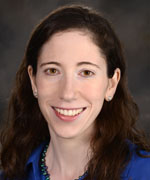
Education: Cornell University, Ithaca, N.Y. (B.S. in biological sciences, 2000); State University of New York at Buffalo School of Medicine, Buffalo, N.Y. (M.D., 2004); Harvard Medical School, Boston (M.M.Sc., 2011)
Training: Residency in pediatrics, Children’s Hospital Pittsburgh, Pittsburgh (2004–2007); clinical fellowship in pediatric endocrinology, Children’s Hospital Boston, Boston (2007–2010); research fellowship in reproductive endocrinology, Massachusetts General Hospital, Boston (2008–2015)
Previous positions: Assistant professor in pediatrics, Harvard Medical School (2013–2015); attending in pediatric endocrinology, Children’s Hospital Boston (2010–2015); endocrine consultant, Newborn Medicine, Brigham and Women’s Hospital, Boston (2010–2015)
Came to NIH: In 2015 as Lasker Clinical Research Scholar
Research Focus: I am interested in determining the physiologic and pathophysiologic underpinnings of irregular menstrual cycles among adolescent girls. Although irregular menstrual cycles are a common part of female development, a subset of teens never make the critical transition to normal menstrual cycles. By investigating the mechanisms underlying irregular cycles after the first menses, including potential genetic and environmental contributors (such as body weight and sleep structure and duration), I hope to identify girls at high risk for future hormonal and metabolic complications who deserve early treatment.
How did you become interested in science and your field?
A “late bloomer” myself, I have been interested in the determinants of pubertal timing since my adolescent years.
What is most exciting about your work?
I love having the tools and independence to be able test novel research hypotheses through clinical investigation. As a clinical researcher, I particularly enjoy the natural flow of ideas back and forth between clinic and the lab. My patients inspire me and challenge me to answer questions that will not only improve their care but also advance general scientific knowledge.
Have you made any significant findings?
My most recent work has focused on the interaction between sleep and reproductive hormone secretion during the early stages of puberty. We found that during puberty, hormone pulses that occur during the night are most likely to occur during deep sleep, suggesting that there may be crosstalk between the sleep and reproductive centers of the brain.
What attracted you to the NIH IRP?
I was drawn to the IRP because my mentor in Boston, Janet Hall, recently became head of clinical research at NIEHS. I was also impressed by the diverse resources available to support junior clinical investigators and the opportunity to develop new cross-disciplinary collaborations.
What’s hot in your field right now?
Investigation of the genetic contributions to reproductive milestones (menarche, menopause) has attracted a lot of attention.
What do you like to do outside of work?
I’m a fitness buff (running, soccer, cycling, yoga, Zumba), and I love to travel and spend time with my husband and 2-year-old daughter.
This page was last updated on Monday, April 25, 2022
